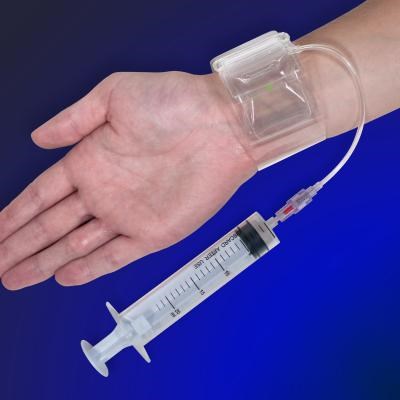Confirmation
PR32: Vascular Compression Band
Applicable To
Introduction
The Vascular Compression Band (VCB) is a device designed to obtain hemostasis of the radial artery post trans-radial cardiac angiography. The device uses an inflatable cushion that sits over the puncture site compressing the radial artery but allowing the ulna artery to supply blood to the hand. A syringe is used to add and remove air.
Assessing the patient is key.
Indications
Contraindications
Procedure
Assessment with Band On
- Check baseline vital signs
- Conduct site check every 15 minutes ensuring to assess circulation:
- Capillary refill (< 2 seconds)
- Pain/tingling/numbness
- Coolness and/or colour change
- Bleeding, swelling, hematoma at site
- O2 saturation of the affected thumb
- Document hematoma if present
- Ensure proper time frame to start removal process
Pre-Removal Assessment
- Note band application time
- Look for band release start time on the post procedure form
- Note how many mLs of air was at starting point
- The usual amount is 15 mL and the maximum amount of air is 18 mL
Band Removal
Use the syringe provided with the band
- Insert syringe tip into the band inflator (air port)
- Ensure the syringe is in the 2 mL deflation position
- Remove 2 mL of air from the inflation balloon every 15 minutes via air port
- Re-assess site for bleeding and hematoma after each deflation
Repeat steps 1 to 4 until all the air is removed from the band
If there is no bleeding:
- Remove the band from the patient's wrist
- Apply Tegaderm dressing
If at any time during the deflation process bleeding occurs, stop the process and re-inflate with the same amount that was removed. This will usually achieve hemostasis.
After the Band Has Been Removed
- Assess site for hematoma or bleeding
- Capillary refill (< 2 seconds)
- Coolness and/or colour change
- O2 saturation of the affected thumb
- Continue the scheduled site checks
- Check every 15 minutes or if hand is used in any way
Conveyance guidelines
- Patient position - of comfort
- Arm position - of comfort; patient is not to use hand
- Wrist movement restrictions - no flexion, extension, or pressure
- IV - in situ and patent (max 500 mL bag attached to patient)
- SpO2 - on while the band is on the patient
Notes
Complications
Bleeding
If bleeding occurs while the band is on, remove the band and apply direct pressure just proximal to the access site for 10 minutes using a gloved hand. Once hemostasis is achieved, continue with site checks.
- If the site continues to bleed after 10 minutes, continue direct pressure and take the patient to the closest hospital
- DO NOT RE-APPLY THE BAND
If bleeding occurs at any time during the deflation process, inject enough air to restore hemostasis (never inflate VCD beyond 18 mL). Wait 30 minutes and then repeat Step 1 of the removal protocol (4.2). Restart scheduled site checks every 15 minutes.
- Document
- Notify receiving hospital
Hematoma
If a hematoma occurs while the band is on:
- Remove the VC band and apply direct pressure just proximal to the access site for 10 minutes
- Outline perimeter
- Refer back to hematoma chart (use the legend on the RCCL document)
- Restart site checks
- Document
- Notify receiving hospital
Neurovascular Compromise
If patient presents the following:
- Capillary refill prolonged (> 2 seconds)
- Cool, pale, or discoloured limb
- Pain/tingling
- Remove 1 mL of air via band air port
- Monitor for improvement
- With improvement: continue site checks as per schedule
- With NO improvement: convey patient to the closest hospital
- Document
- Notify receiving hospital
Resources

References
- Kern, M. et al. The Cardiac Catheterization Handbook (6th ed). 2016.
- Vascular Solutions Inc. VASC™ Band Hemostat [Product Reference Sheet]. [Link]
Changelog:
- 2023-06-13: enabled VCB for EMR scope of practice